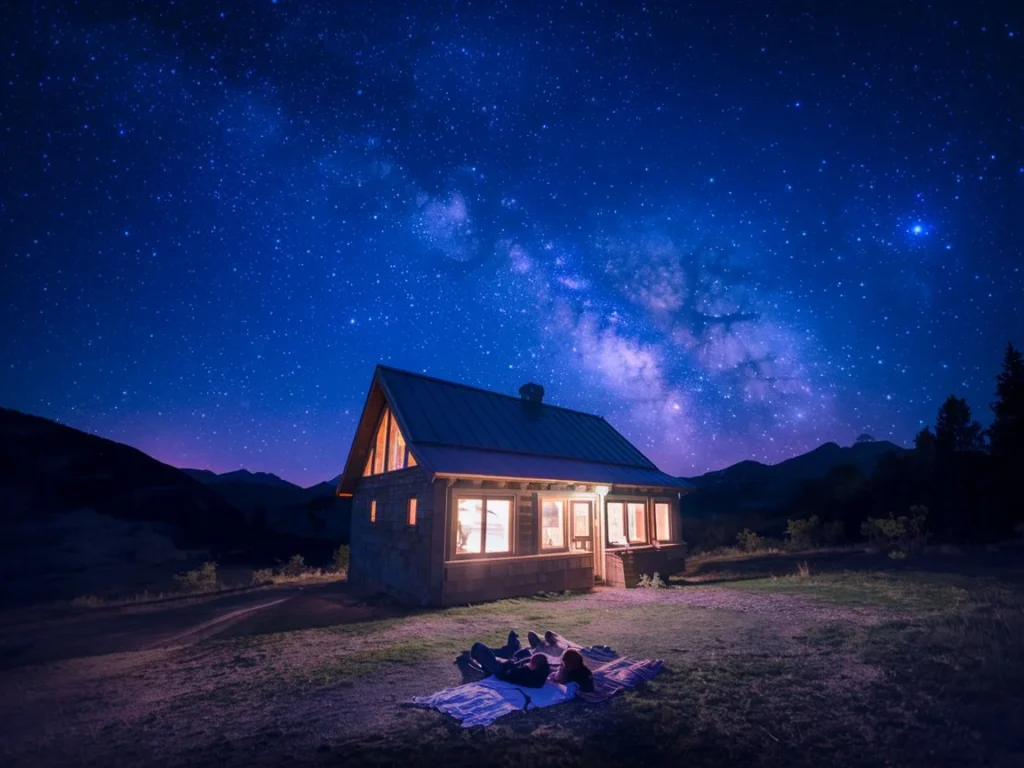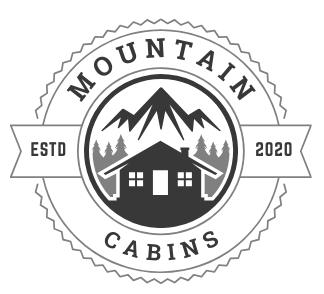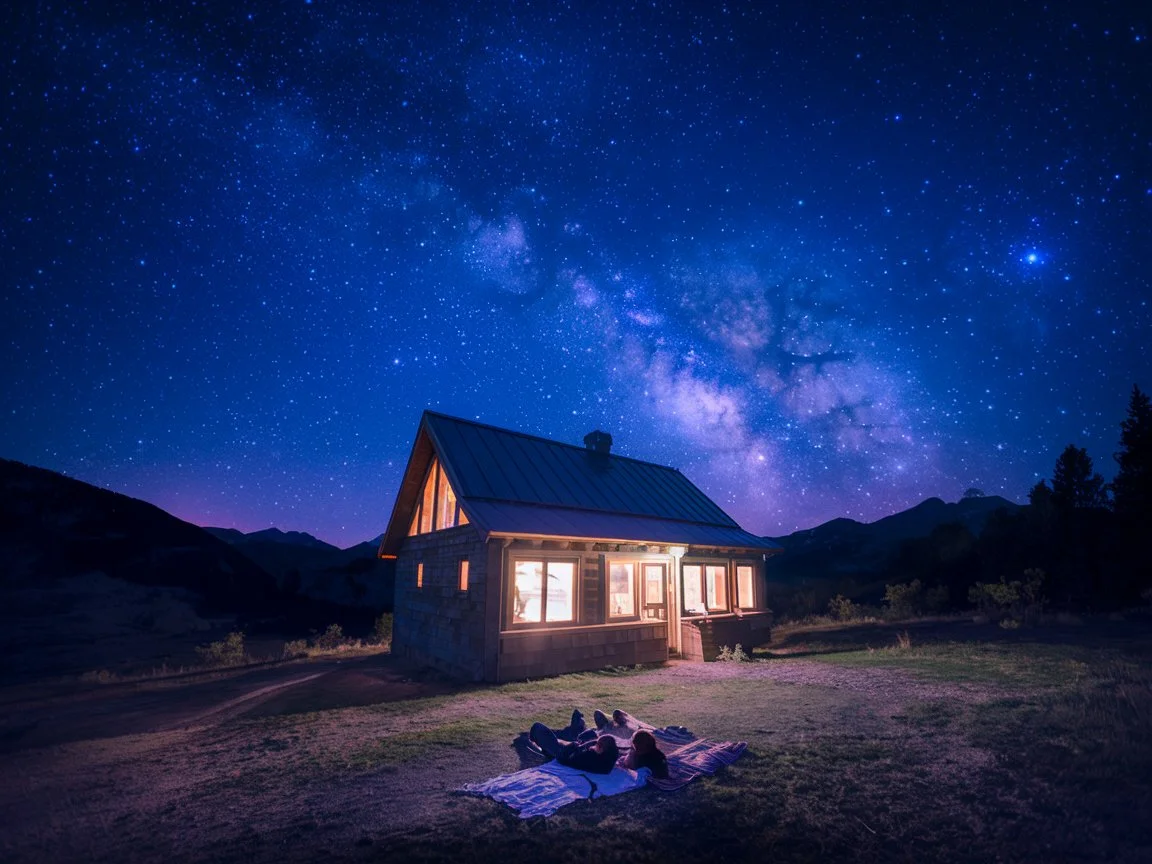
Introduction
Stargazing from a mountain cabin is a truly magical experience, offering an unobstructed view of the night sky far from city lights. The peaceful surroundings of a remote cabin create the perfect atmosphere to immerse yourself in the beauty of the cosmos. Whether you’re an amateur astronomer or simply love gazing at the stars, the clear, dark skies of a mountain retreat provide an unforgettable opportunity to connect with the universe.
In this guide, we’ll explore the best locations for stargazing, essential gear, key celestial events, and tips for making the most of your experience. By the end, you’ll be ready to create unforgettable memories under the stars.
Best Locations for Stargazing from Mountain Cabin
Grand Teton National Park, USA
Nestled in Wyoming, Grand Teton National Park offers breathtaking views of the Milky Way. The park’s high elevation and minimal light pollution make it a favorite for stargazers. Bring a telescope or simply lie back on a blanket to witness shooting stars and distant galaxies.
Jasper National Park, Canada
As one of the largest dark sky preserves in the world, Jasper National Park provides an exceptional stargazing experience. Visitors can spot constellations, meteor showers, and even the Northern Lights on certain nights. The annual Jasper Dark Sky Festival is a must-visit for astronomy enthusiasts.
Atacama Desert, Chile
For an out-of-this-world experience, head to Chile’s Atacama Desert. With an extremely dry climate and high altitude, this region has some of the clearest skies on Earth. Observatories here provide guided tours, offering an up-close look at planets and star clusters.
Aoraki Mackenzie, New Zealand
New Zealand’s Aoraki Mackenzie Dark Sky Reserve is a designated stargazing haven. This area boasts some of the darkest skies in the Southern Hemisphere, making it an excellent place to view the Southern Cross and Magellanic Clouds.
For more breathtaking locations near mountain retreats, check out our guide on the best hiking trails near mountain cabins.
Understanding the Night Sky: Key Celestial Events
Recognizing Constellations
Identifying constellations adds excitement to any stargazing adventure. Look for well-known patterns such as Orion, the Big Dipper, and the Southern Cross. With a star map or an app, you can easily find these formations.
Key Events to Watch
- Meteor Showers: The Perseids (August) and Geminids (December) offer spectacular shooting stars.
- Lunar Eclipses: A blood moon can be an awe-inspiring sight from a dark mountain cabin.
- Planetary Alignments: Occasionally, planets align in a way that makes them easily visible to the naked eye.
Using apps like SkyView or Stellarium can help you locate planets, stars, and upcoming celestial events.
Stargazing Gear You’ll Need for Your Mountain Cabin Trip
Telescopes vs. Binoculars
A telescope is excellent for deep-sky viewing, but binoculars are more portable and easier for beginners. If you’re just starting, a 10×50 binocular is ideal for spotting star clusters and planets.
Essential Accessories
- Red Flashlight: Preserves night vision while navigating in the dark.
- Star Map or App: Helps locate constellations and planets.
- Warm Clothing & Blankets: Nights in the mountains can get chilly, even in summer.
How to Maximize Your Stargazing Experience
Finding the Best Spot
To enjoy the clearest view, move away from cabin lights and choose an open space with an unobstructed sky view.
Adjusting to the Darkness
Your eyes need about 20-30 minutes to adjust fully to the dark. Avoid looking at bright lights to preserve night vision.
Creating a Cozy Atmosphere
Bring blankets, hot cocoa, and comfortable seating to enhance your experience. A reclining chair or hammock makes stargazing more enjoyable.
Capturing the Night Sky: Astrophotography Tips
Choosing the Right Camera
A DSLR camera with manual settings works best for astrophotography. Use a wide-aperture lens to capture more light.
Long Exposure Photography
Set your camera to a long exposure (15-30 seconds) to capture more details in the sky. A tripod is essential to prevent blurry images.
Minimizing Light Pollution
If you’re near any artificial light, use a light pollution filter to enhance clarity in your photos.
For additional photography tips, check out this comprehensive guide from NASA’s Astrophotography Tips.
Stargazing Safety and Comfort Tips
Staying Safe in Remote Areas
When venturing outside at night, carry a flashlight and be aware of wildlife. Some areas may have nocturnal animals, so make noise to avoid startling them.
Dressing for Cold Nights
Even in summer, mountain temperatures can drop significantly. Wear layered clothing, hats, and gloves to stay warm.
Being Mindful of Outdoor Hazards
Avoid venturing too far from your cabin at night, especially in rugged terrain. If hiking to a stargazing spot, let someone know your location beforehand.
Conclusion
Stargazing from a mountain cabin offers an unforgettable way to experience the beauty of the universe. Whether you’re spotting constellations, capturing celestial moments with your camera, or simply enjoying the peacefulness of the night, the experience is truly magical.
By choosing the right location, packing the right gear, and following safety tips, you can make the most of your time under the stars. So grab a blanket, step outside, and let the wonders of the night sky unfold before you.

